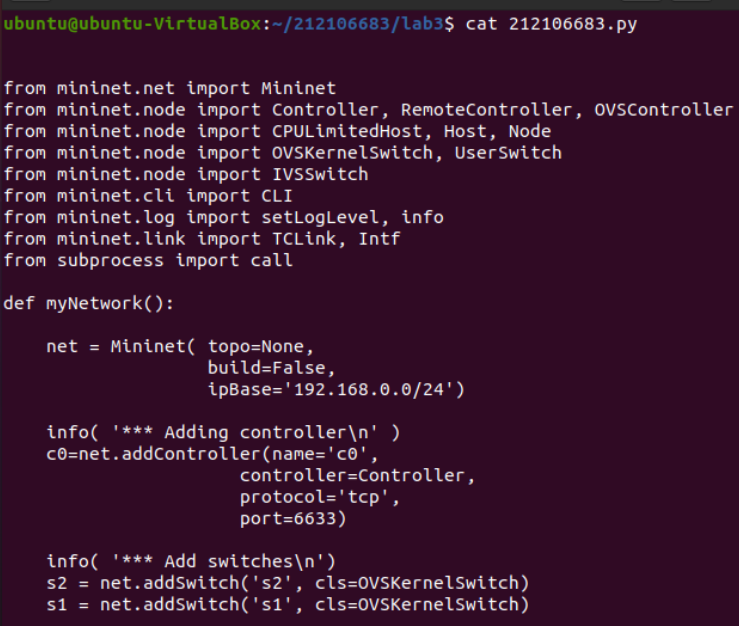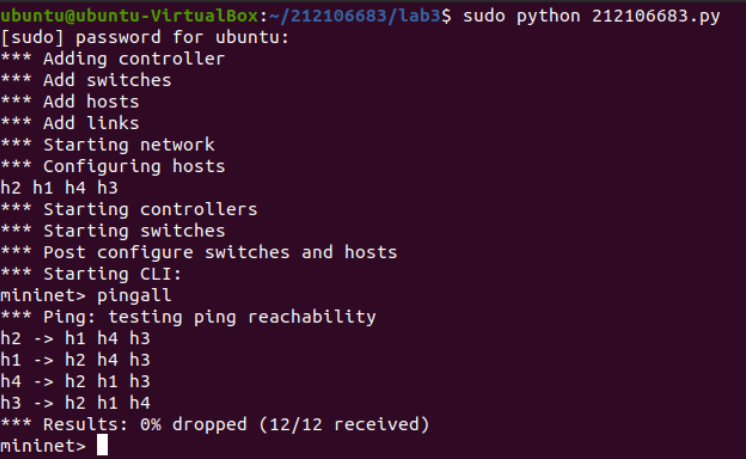实验3:OpenFlow协议分析实践
实验3:OpenFlow协议分析实践
一、实验目的
- 能够运用 wireshark 对 OpenFlow 协议数据交互过程进行抓包;
- 能够借助包解析工具,分析与解释 OpenFlow协议的数据包交互过程与机制。
二、实验环境
Ubuntu 20.04 Desktop amd64
三、实验要求
(一)基本要求
- 搭建下图所示拓扑,完成相关 IP 配置,并实现主机与主机之间的 IP 通信。用抓包软件获取控制器与交换机之间的通信数据。
![]()
| 主机 | IP地址 |
|---|---|
| h1 | 192.168.0.101/24 |
| h2 | 192.168.0.102/24 |
| h3 | 192.168.0.103/24 |
| h4 | 192.168.0.104/24 |


2.查看抓包结果,分析OpenFlow协议中交换机与控制器的消息交互过程,画出相关交互图或流程图。
(1)HELLO
控制器6633端口(我最高能支持OpenFlow 1.0) ---> 交换机41390端口
交换机41390端口(我最高能支持OpenFlow 1.5) ---> 控制器6633端口

于是双方建立连接,并使用OpenFlow 1.0
(2)FEATURES_REQUEST
从控制器6633端口到交换机41390端口,请求特征信息。

(3)SET_CONFIG
控制器6633端口(请按照我给你的flag和max bytes of packet进行配置) ---> 交换机41390端口

(4)FEATURES_REPLY
交换机41390端口(这是我的特征信息,请查收) ---> 控制器6633端口

(5)PACKET_IN
交换机41390端口(有数据包进来,请指示)--- 控制器6633端口

(6)FLOW_MOD
分析抓取的flow_mod数据包,控制器通过6633端口向交换机41390端口下发流表项,指导数据的转发处理

(7)PACKET_OUT
控制器6633端口(请按照我给你的action进行处理) ---> 交换机41390端口


3.回答问题:交换机与控制器建立通信时是使用TCP协议还是UDP协议?
使用TCP协议,如图所示可以看出,拓扑文件中也有写出是使用TCP协议


(二)进阶要求
将抓包基础要求第2步的抓包结果对照OpenFlow源码,了解OpenFlow主要消息类型对应的数据结构定义。
(1)HELLO

/* Header on all OpenFlow packets. */ struct ofp_header { uint8_t version; /* OFP_VERSION. */ uint8_t type; /* One of the OFPT_ constants. */ uint16_t length; /* Length including this ofp_header. */ uint32_t xid; /* Transaction id associated with this packet. Replies use the same id as was in the request to facilitate pairing. */ };
(2)FEATURES_REQUEST
源码与OFPT_HELLO代码一致(因为ofp_header为所有报文的头)
(3)OFPT_SET_CONFIG

/* Switch configuration. */ struct ofp_switch_config { struct ofp_header header; uint16_t flags; /* OFPC_* flags. */ uint16_t miss_send_len; /* Max bytes of new flow that datapath should send to the controller. */ };
(4)OFPT_FEATURES_REPLY

/* Switch features. */ struct ofp_switch_features { struct ofp_header header; uint64_t datapath_id; /* Datapath unique ID. The lower 48-bits are for a MAC address, while the upper 16-bits are implementer-defined. */ uint32_t n_buffers; /* Max packets buffered at once. */ uint8_t n_tables; /* Number of tables supported by datapath. */ uint8_t pad[3]; /* Align to 64-bits. */ /* Features. */ uint32_t capabilities; /* Bitmap of support "ofp_capabilities". */ uint32_t actions; /* Bitmap of supported "ofp_action_type"s. */ /* Port info.*/ struct ofp_phy_port ports[0]; /* Port definitions. The number of ports is inferred from the length field in the header. */ };
(5)OFPT_PACKET_IN
有两种情况:
交换机查找流表,发现没有匹配条目,但是这种包没有抓到过
enum ofp_packet_in_reason { OFPR_NO_MATCH, /* No matching flow. */ OFPR_ACTION /* Action explicitly output to controller. */ };

/* Packet received on port (datapath -> controller). */ struct ofp_packet_in { struct ofp_header header; uint32_t buffer_id; /* ID assigned by datapath. */ uint16_t total_len; /* Full length of frame. */ uint16_t in_port; /* Port on which frame was received. */ uint8_t reason; /* Reason packet is being sent (one of OFPR_*) */ uint8_t pad; uint8_t data[0]; /* Ethernet frame, halfway through 32-bit word, so the IP header is 32-bit aligned. The amount of data is inferred from the length field in the header. Because of padding, offsetof(struct ofp_packet_in, data) == sizeof(struct ofp_packet_in) - 2. */ };

/* Send packet (controller -> datapath). */ struct ofp_packet_out { struct ofp_header header; uint32_t buffer_id; /* ID assigned by datapath (-1 if none). */ uint16_t in_port; /* Packet's input port (OFPP_NONE if none). */ uint16_t actions_len; /* Size of action array in bytes. */ struct ofp_action_header actions[0]; /* Actions. */ /* uint8_t data[0]; */ /* Packet data. The length is inferred from the length field in the header. (Only meaningful if buffer_id == -1.) */ };
(7)FLOW_MOD

/* Flow setup and teardown (controller -> datapath). */ struct ofp_flow_mod { struct ofp_header header; struct ofp_match match; /* Fields to match */ uint64_t cookie; /* Opaque controller-issued identifier. */ /* Flow actions. */ uint16_t command; /* One of OFPFC_*. */ uint16_t idle_timeout; /* Idle time before discarding (seconds). */ uint16_t hard_timeout; /* Max time before discarding (seconds). */ uint16_t priority; /* Priority level of flow entry. */ uint32_t buffer_id; /* Buffered packet to apply to (or -1). Not meaningful for OFPFC_DELETE*. */ uint16_t out_port; /* For OFPFC_DELETE* commands, require matching entries to include this as an output port. A value of OFPP_NONE indicates no restriction. */ uint16_t flags; /* One of OFPFF_*. */ struct ofp_action_header actions[0]; /* The action length is inferred from the length field in the header. */ };
个人总结
实验难度
这次实验建立在前几次的实验室的基础上,有前面的基础再进行实验操作还算较为顺利。主要是抓包完成后,要对控制机跟交换机之间验证、交流信息的情况进行相应的查询。这要求对这二者之间工作原理有所掌握,这些内容老师课堂上有讲解过,基本就是二者的交互图。
实验困难
有前几次的实验基础,难度不算很大。在抓包后有碰到两个小问题,一是抓包选择,依照lab2选择具体的抓包,没有一开始抓取“any”这个抓包;二是pingall后,抓包一直在跑停不下来,正好鼠标左击出了点问题,后面通过触摸板点击后,用上下方向箭来选择相应的抓包行。
个人感想
这个实验操作,要求对OpenFlow协议的原理有足够的理解,再结合之前的操作基础,对抓包后的内容能进行简单的分析。需要掌握清楚相互间的几个“命令”消息所代表的含义跟目的作用,这样再去查询就比较清晰,能理解所代表的含义。








 浙公网安备 33010602011771号
浙公网安备 33010602011771号